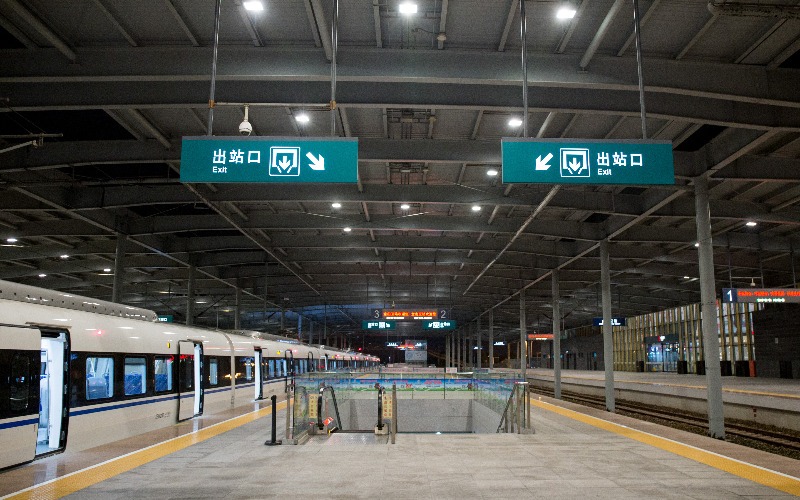What is China's High-Speed Rail (HSR)? Generally speaking, a rail network that offers 200–350 kph (124–217 mph) trains is an HSR network. Now, China has the largest high-speed rail network in the world. At the end of 2022, there were about 42,000 kilometers (26,097 miles) of high-speed rail lines in service.
- Chinese: 中国高速铁路 Zhōngguó Gāosù Tiělù /jong-gwor gaoww-soo tyeah-loo/
- Passenger capacity: 2 billion people annually (data from 2018, before Covid-19's affection)
- Speed: 200–350 kph (124–217 mph), e.g. Beijing to Shanghai takes 5 hours to travel 1,200 km
- Facilities on an HSR train: non-smoking, adjustable seats, 220V AC sockets, Western/Chinese style toilets, free boiling/cold water, restaurant car, and a canteen bar
11 Popular HSR Routes and Maps in China
There are "5 vertical lines and 6 horizontal lines" for the main China HSR network. This means there are four north–south high-speed rail lines and four east–west high-speed rail lines. They are the basis for the China high-speed rail network.
The Five north–south HSR lines in China:
- Beijing–Shanghai route
- Beijing–Guangzhou–Shenzhen–Hong Kong route
- Shanghai–Harbin route
- Jining-Kunming route (under construction)
- Xi'an-Zhanjiang route (under construction)
The Six east–west HSR lines in China:
- Shanghai-Nanning route
- Shanghai–Chengdu route
- Shanghai-Kunming route
- Qingdao–Yinchuan route
- Shenyang–Lanzhou route (under construction)
- Yancheng-Xinning route (under construction)
Beijing–Shanghai High-Speed Railway (Fully Operational)
- Chinese: 京沪高速铁路 'Beijing–Shanghai HSR'
- Length: 1,318 km (819 mi)
- Design speed: 350 kph (217 mph)
- Main stops: Beijing South, Jinan West, Nanjing South, Suzhou North, Shanghai Hongqiao
It connects two popular cities and reduces the journey time from 12 hours to 5 hours (2 hours by air). Beijing and Shanghai are also two of the most popular tourist cities, and travelers often experience China HSR trains on this route for the first time.
Read more about the Beijing–Shanghai HSR Travel Route to get ideas for planning a trip.
Beijing–Guangzhou–Shenzhen–Hong Kong High-Speed Route (Fully Operational)
- Chinese: 京广深港高速铁路 'Beijing–Guangzhou–Shenzhen–Hong Kong HSR'
- Length: 2,240 km (1,392 mi)
- Design speed: 350 kph (217 mph)
- Main stops: Beijing West, Shijiazhuang, Zhengzhou East, Wuhan, Changsha South, Hengyang East, Guangzhou South, Shenzhen North, Hong Kong
Beijing–Guangzhou–Shenzhen–Hong Kong High-Speed Route is the longest passenger dedicated high-speed rail line in the world, consisting of Beijing–Guangzhou, Guangzhou–Shenzhen and Shenzhen–Hong Kong high-speed railways. The Beijing–Guangzhou HSR section was opened in 2012. And the Guangzhou–Shenzhen–Hong Kong HSR section was put into service in September, 2018. It connects North China, Central China, and South China.
Shanghai–Harbin High-Speed Route (Fully Operational)
- Chinese: 沪哈高速铁路 'Shanghai–Harbin HSR
- Length: 2,421 km (1504 mi)
- Design speed: 350 kph (217 mph)
- Main stops: Shanghai, Qingdao, Dalian, Shenyang, Changchun West, Harbin West
It connects Northeast China with China's economic center, Shanghai. It cuts the journey time from 24 hours to 12 hours between Shanghai and Harbin..
Jining–Kunming High-Speed Route (Partly Operational)
- Chinese: 集昆高铁 'Jining–Kunming HSR'
- Length: Estimated 3,000 km (1864 mi)
- Design speed: 250–350 kph (155–217 mph)
- Main stops:Jining, Datong, Taiyuan South, Xi'an, Chengdu, Kunming
It connects China’s northeast and southeast parts. Jining District is the economic, cultural, and political center of Ulanqab City, Inner Mongolia region. And Kunming is the capital of Yunnan province. Currently, only around one third of this route are operational.
Xi'an–Zhanjiang High-Speed Route (Partly Operational)
- Chinese: 西湛高铁 'Xi'an-Zhanjiang HSR'
- Length: Estimated 2,200 km (1,367 mi)
- Design speed: 200–250 kph (124–155 mph)
- Main stops: Xi'an, Chongqing, Zunyi, Guiyang, Nanning, Beihai, Zhanjiang
Xi’an is one of the largest cities in Northwest China, and Zhanjiang is an important port in the east coast of China. This high-speed railway plays a role as “Modern Silk Road”. Half of this route are in operation now.
Shanghai–Wuhan–Chengdu High-Speed Route (Fully Operational)
- Chinese: 沪汉蓉高铁 'Shanghai–Wuhan–Chengdu HSR'
- Length: 1,600 km (994 mi)
- Design speed: 160–350 kph (99–217 mph)
- Main stops: Shanghai Hongqiao, Nanjing South, Hefei South, Hankou, Yichang East, Chongqing North, Chengdu East
This HSR is built alongside the Yangtze River. The high-speed trains on most of the route have an average speed of 200 to 250 kph, except on the line from Shanghai to Nanjing (350 kph), and from Yichang to Wanzhou (160 kph) because of the curves in the track that were designed to get around the landforms in the area.
Until the line from Lichuan to Chongqing becomes operational, you can travel from Shanghai to Yichang, from Yichang to Wanzhou, and from Chongqing to Chengdu by high-speed trains. Taking a Yangtze River Three Gorges cruise between Chongqing and Yichang would be a nice way to break up a high-speed train journey if you have time to take in the scenery.
Shanghai–Guangzhou-Nanning High-Speed Route (Fully Operational)
- Chinese: 沪南高铁 'Shanghai-Nanning HSR'
- Length: 2,015 km (1252 mi)
- Design speed: 250–350 kph (155–217 mph)
- Main stops: Shanghai, Fuzhou, Xiamen, Guangzhou, Nanning
Nanning, the capital of Guangxi region, is a gateway for the trade between Southeastern countries and China. And Shanghai is the economic center of China. High-speed trains connects these two important cities in just 12 hours.
Shanghai–Hangzhou–Changsha–Guiyang–Kunming High-Speed Route (Fully Operational)
- Chinese: 沪昆高铁 'Shanghai–Kunming HSR'
- Length: 2,266 km (1,408 mi)
- Design speed: 350 kph (217 mph)
- Main stops: Shanghai Hongqiao, Hangzhou East, Nanchang Xi, Changsha South, Guiyang North, Kunming South
The scenery along the Shanghai-Kunming route is very beautiful thanks to the karst landscape and minority culture. Thousands of people in Shanghai hop on a train to Kunming or Guiyang in order to escape from the hustle and bustle of their daily life.
Qingdao-Yinchuan High-Speed Route (Fully Operational)
- Chinese:青银高铁 'Qingdao–Yinchuan HSR'
- Length: 1,524 km (947 mi)
- Design speed: 350 kph (217 mph)
- Main stops: Qingdao, Jinan, Shijiazhuang, Taiyuan, Yinchuan
Shenyang-Lanzhou High-Speed Route (Partly Operational)
- Chinese:沈兰高铁 'Shenyang–Lanzhou HSR'
- Length: Estimated 2,300 km (1,429 mi)
- Design speed: 350 kph (217 mph)
- Main stops: Shenyang, Beijing, Hohhot, Yinchuan, Zhongwei, Lanzhou
Shenyang and Lanzhou are respectively located in Northeast and Southeast China. Although they are both north cities, the landscapes are totally different. Only one third of the route has been in operation so far.
Yancheng-Xining High-Speed Route (Partly Operational)
- Chinese: 盐西高铁 'Yancheng–Xinning HSR'
- Length: Estimated 2,100 km (1,305 mi)
- Design speed: 350 kph (217 mph)
- Main stops: Yancheng, Xuzhou West, Zhengzhou, Luoyang, Xi'an, Lanzhou, Xining
Regional Intercity HSR Lines
Regional intercity HSR lines are short-distance, passenger-dedicated high-speed lines connecting cities in the same province, area, or regional. They are independent from the national high-speed rail grid, with an average speed of 200 to 250 km/h, sometimes up to 300km/h. Operational intercity HSR lines in China are listed below:
| HSR Line | Distance (km) | Design Speed (km/h) | Duration |
|---|---|---|---|
| Beijing–Tianjin Intercity Railway | 115 | 350 | 35–57min |
| Shanghai–Nanjing Intercity Railway | 301 | 350 | 1h 7min–3h 33min |
| Nanchang–Jiujiang Intercity Railway | 131 | 250 | 1h–1h 10min |
| Shanghai–Hangzhou Intercity Railway | 169 | 350 | 1h |
| Chengdu–Dujiangyan Intercity Railway | 65 | 220 | 19–39min |
| Changchun–Jilin Intercity Railway | 111 | 250 | 40–50min |
| Guangzhou–Zhuhai Intercity Railway | 117 | 200 | 59min–1h 24min |
| Guiyang–Kaiyang Intercity Railway | 62 | 200 | 48 min–1h 7min |
See more Popular Train Travel Routes.
China High-Speed Rail Development
First China High-Speed Train Opened in Time for the Beijing 2008 Olympics
The construction of HSR in China began with the building of the Qinhuangdao–Shenyang Passenger Dedicated Line (秦皇岛–沈阳客运专线) in 1999 (it opened in 2003), offering a service of 250 kph (155 mph), although it's not recognized as a China HSR.

The first China HSR offering 350 kph (217 mph) services was the Beijing–Tianjin Intercity Railway, which has been in service since August 1, 2008.
- Chinese: 京津城际铁路 'Beijing–Tianjin Intercity Railway'
- Length: 120 km (75 mi)
- Design speed: 350 kph (217 mph)
- Main stops: Beijing Nan, Yizhuang, Wuqing, Tianjin
This was the first HSR that allowed trains to operate faster than 300 kph. It takes about 30 minutes to get from Beijing to Tianjin.
If you take a cruise from Tianjin, this is a good choice for you to begin your China tour in Beijing, and it's also a very convenient way to catch your cruise in Tianjin when traveling from Beijing. Read more about the Best Ways to Get from Beijing to Tianjin Port.
Ambitious for Bullet Trains — Larger, Faster, Most Advanced
China's high-speed rail plans are ambitious, planning to invest $300 billion to construct the largest, fastest, and most technologically advanced high-speed railway system in the world by 2020. It is predicted that the HSR (High-Speed Railway) network will reach 30,000 kilometers (18,641 mi) when the major rail lines are completed.
China High-Speed Railway Map
High-speed rail networks in China are more widely covered in central and eastern China than in western China, with the latter region's HSR currently being under construction for economic development.
Most cities have high-speed railways, such as Beijing, Shanghai, Xi'an, Guilin, Hangzhou, Tianjin, Guangzhou, Shenzhen, Chongqing, Nanjing, Chengdu, Changsha, Harbin, Guiyang, Kunming, Xining, Changchun, Shenyang, Dalian, Shijiazhuang, Taiyuan, Jinan, Qingdao, Zhengzhou, Luoyang, Hefei, Nanjing, Nanchang, Wuhan, Lanzhou, Urumqi, Fuzhou, Xiamen, and Nanning. But cities like Lhasa and Shigatze haven't opened high-speed railways yet.
It is handy to know that even if two cities have high-speed railway stations, there may not be a train running between the two cities, e.g. Guilin and Xi'an are two popular tourist cities and both cities have high-speed railway stations, but there are no high-speed trains currently running between these two cities.
Please see the China High-Speed Railway Lines Network Map above to see if there are trains running between the two cities you are planning to visit on your tour, or just search the train schedule at China Highlights Train Ticket Service.
Shanghai Maglev High-Speed Rail
Shanghai's Maglev Train was the first magnetically levitated high-speed train line in operation in the world. It is owned and operated by Shanghai's city government. All other high-speed trains in China are owned and operated by China Railway Corporation.
Shanghai's Maglev Train, launched in 2004, has a maximum speed of 431 kph. It runs between Shanghai Pudong International Airport and Shanghai's Longyang Road Metro Station at intervals of 15 to 20 minutes. The journey only takes about 8 minutes, and a one-way ticket is 50 yuan.
Big Events for China's High-Speed Rail
Aug. 1, 2008: The first HSR (Beijing–Tianjin route) opened.
Dec. 26, 2009: The longest and most complicated Wuhan–Guangzhou line (part of the Beijing–Guangzhou–Shenzhen–Hong Kong route) opened.
Feb. 6, 2010: The first HSR built on a collapsible loess area (Zhengzhou—Xi'an route) opened.
Dec. 1, 2012: The first HSR built on a high latitude area (Harbin–Dalian route) opened.
Nov. 25, 2015: Seventeen leaders from 17 countries took an HSR train from Suzhou to Shanghai.
Feb. 25, 2018: Fuxinghao train began to serve on Beijing-Guangzhou High-Speed Railway.
Jun. 25, 2021: Lhasa to Nyingchi high-speed railway was offcially put into operation.
Dec. 7th, 2022: A negative PCR test result became unnecessary to take a train in China.
Jan. 15th, 2023: High-speed trains from West Kowloon in Hong Kong to China mainland were resumed.
Experience China Bullet Train in Your China Trip
If you are interested in experiencing a bullet train in your China trip, please see our popular tours below for inspiration:
- 5-Day Shanghai, Hangzhou and Suzhou Bullet Train Tour
- CLASSIC WONDERS — 11 Days Beijing, Xi'an, Guilin/Yangshu, Shanghai Private Tour
- More China tours
Or you can just tell us your interests and requirements, and we can help you create a China tour.








